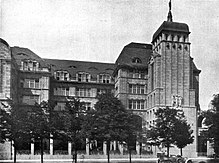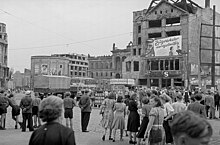Bierhaus Siechen
The beer Siechen was from 1883 to 1945, a beer palace in Berlin district of Mitte ; first at Behrenstrasse 24 and then from 1911 to 1920 at Potsdamer Platz .
prehistory
The sickness had a predecessor in Berlin since 1845. The first beer house at Neumannsgasse 6 was also known as "The Eternal Lamp" by its regular guests. Under the same name, The Eternal Lamp , the innkeeper Dr. [Carl] Siechen und Familie published the first of the Berlin revolutionary satirical papers on April 26, 1848. The newspaper appeared from January 1849 because of its prohibition by General Friedrich von Wrangel under the modified title The eternal lamp and remained on the market until 1850. Since there was soon no longer enough space for the guests, the Siechen moved to the Alte Post in Königstrasse, today: Rathausstrasse , corner of Burgstrasse 7 at Kurfürstenbrücke . Carl sick died in 1869 and was on the St. Mary and St. Nicholas Cemetery I buried. His son Franz Siechen took over the beer house, which had meanwhile moved to Jägerstrasse 63. It now bore the name of the family and, as Berolinism, the nickname "Infirmary House" (based on an infirmary ). On April 2, 1875, the export beer of the Nuremberg Reif brewery was sold for the first time near Siechen in the Reich capital .
Bierhaus Siechen on Behrenstrasse
On 18 October 1883, the new by architect opened Armin Wegner designed historicist home sick in Behrenstraße 24 near the Friedrichstrasse. The Standardwerk Berlin and its buildings praised the new building in 1896 as "an excellent achievement for its time" and refers specifically to the innovative ventilation systems that are important for the bar rooms. The exhaust air was extracted through openings in the ceiling voute without a disturbing draft .
Its location on Behrenstrasse in Berlin-Mitte and its good reputation have made it the place of well over 100 regulars for diplomats , artists , officers , scholars , corporates , politicians and civil servants over the years . Theodor Fontane mentions the sickness in the 35th chapter of the book Effi Briest , published in 1896 : “Three Seidel calm down every time.” In his poem Noctambulatio , composed in 1924, the poet Ringelnatz clearly shows the character of the sickness as a meeting place for the upper class.
The house on Behrenstrasse existed until the Second World War and was only destroyed on May 2, 1945.
Bierhaus Siechen on Potsdamer Platz
In 1909/1910, the family had the beer palace designed by the architect Johann Emil Schaudt built on the property at Potsdamer Platz 3, which was also opened under the name Bierhaus Siechen in 1910. The guest rooms were on the ground floor and on the first floor.
The Siechen beer house was last listed in this large building in the Berlin address book in 1920. From the Berlin address book in 1921 , the inn is only registered in the parent company Behrenstrasse 23/24. At the same time, ownership of this house passed from Siechen, M. and Franz, C. to Potsdamer Platz Aktiengesellschaft.
The building was then rented to other traders and associations from 1921 to 1925.
Pschorr House on Potsdamer Platz
From 1925 until the end of the Second World War, the large beer palace built by Siechen at Potsdamer Platz 3 was again operated as a pub by the owners Abler, Meifalz and Feitsch under the beer brand Pschorr and is therefore better known as the Pschorr-Haus on Potsdamer Platz . The neon signs on the Pschorr-Haus shaped the image of Potsdamer Platz in the 1920s and 1930s.
The Pschorr-Haus on Potsdamer Platz was badly damaged in the air raids on Berlin in 1943 and was in the British sector after the end of the war because the property belonged to the Tiergarten district . During the World Youth Games in August 1951, there was a large poster on the front of the building that advertised the DEFA film Train Traffic, which addressed an East-West conflict in the divided city. The ruin of the beer house was demolished in 1952.
literature
- Fedor von Zobeltitz : Chronicle of the society under the last empire. Volume 2: 1902-1914. 2nd Edition. Alster-Verlag, Hamburg 1922, p. 221 f.
- H. Hilbert, Fr. Willuhn , H. Lippold: The Masurian evenings in Berlin. In: Corps newspaper of the Altmark Masuria. 51. Kiel 1972, p. 1085 f.
Web links
Individual evidence
- ^ Adolf Wolff: Berliner Revolutions-Chronik: Presentation of the Berlin movements in 1848 according to political, social and literary relationships, Volume 2 . 1852, p. 397 ff.
- ↑ Proof in the journal database
- ↑ The Eternal Lamp No. 1 of May 1, 1848 (PDF)
- ^ Editor then Arthur Müller (writer)
- ↑ The Eternal Lamp No. 1 from January 1, 1849 ( Memento from April 8, 2014 in the Internet Archive )
- ↑ Hans Meyer: The right Berliner in words and idioms. 6th edition. Hermann, Berlin 1904, p. 167.Digitized by the Central and State Library Berlin, 2007. https://digital.zlb.de/viewer/image/14707251/185/
- ↑ Architects Association of Berlin and Association of Berlin Architects (ed.): Berlin and its buildings. 2nd volume. Wilhelm Ernst & Sohn, Berlin 1896, p. 3/4. Digitized by the Central and State Library Berlin, 2017. https://digital.zlb.de/viewer/image/16337878/640/
- ^ Joachim Ringelnatz : Noctambulatio on Wikisource
- ↑ a b Siechen at Potsdamer Platz . In: District lexicon of the Luisenstädtischer Bildungsverein
- ↑ Note: The art publisher Max O'Brien & Co. Berlin published a postcard in 1910 showing the finished and obviously already in operation Bierhaus Siechen on “Potsdamerplatz”. The postmark on the postcard is from August 1, 1910.
- ^ Entry of the Siechen inn in the Berlin address book in 1921
- ↑ address entry of the restaurant Pschorr am Potsdamer Platz 3 in Berlin Address 1926
Coordinates: 52 ° 30 ′ 55.5 " N , 13 ° 23 ′ 14.8" E



